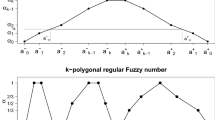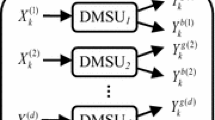Abstract
The present paper proposes a number of models for calculating the average efficiency of two-stage networks using DEA and DEA-R with fuzzy data. If the input, intermediate, and output parameters are available in a two-stage network, DEA and DEA-R models can be used to compute the efficiency. When evaluating decision-making units (DMUs) in two-stage network DEA, the respective programming models are fractional. Meanwhile, in DEA-R, the proposed programming models are linear. Although, it is necessary that the output-to-input ratios (output-orientation) or vice versa (input orientation) be defined and available. Furthermore, DEA-R models can also evaluate DMUs with a network structure when only ratio data are available. Generally, using fuzzy data is necessary for an accurate evaluation of organizations with a two-stage network structure. Therefore, in the present article, using the α-cut approach, an average efficiency model is proposed for the first and second stages of a network structure. At the end, a comparison is made between the mean efficiency scores of a number of airlines by considering fuzzy data in two-stage network DEA and DEA-R.



Similar content being viewed by others
Notes
The data used in this study can be observed at the web address https://www.cao.ir/statistical-yearbook, which is the official website of the Iranian Civil Aviation Organization.
References
Chames, A., Cooper, W.W., Rhodes, E.: Measuring the efficiency of decision making units. Eur. J. Oper. Res. 2(6), 429–444 (1978)
Banker, R.D., Charnes, A., Cooper, W.W.: Some models for estimating technical and scale inefficiencies in data envelopment analysis. Manage. Sci. 30(9), 1078–1092 (1984)
Golany, B., Yu, G.: Estimating returns to scale in DEA. Eur. J. Oper. Res. 103(1), 28–37 (1997)
Liu, J.S., et al.: A survey of DEA applications. Omega 41(5), 893–902 (2013)
Titko, J., Jureviciene, D.: DEA application at cross-country benchmarking: latvian vs Lithuanian banking sector. Procedia Soc. Behav. Sci. 110, 1124–1135 (2014)
Sueyoshi, T., Yuan, Y., Goto, M.: A literature study for DEA applied to energy and environment. Energy Econ. 62, 104–124 (2017)
Emrouznejad, A., Amin, G.R.: DEA models for ratio data: convexity consideration. Appl. Math. Model. 33(1), 486–498 (2009)
Gidion, D.K., et al.: Network DEA models for assessing urban water utility efficiency. Utilities Policy 57, 48–58 (2019)
Hatami-Marbini, A., Toloo, M.: Data envelopment analysis models with ratio data: a revisit. Comput. Ind. Eng. 133, 331–338 (2019)
Olesen, O.B., Petersen, N.C., Podinovski, V.V.: Efficiency analysis with ratio measures. Eur. J. Oper. Res. 245(2), 446–462 (2015)
Olesen, O.B., Petersen, N.C., Podinovski, V.V.: Efficiency measures and computational approaches for data envelopment analysis models with ratio inputs and outputs. Eur. J. Oper. Res. 261(2), 640–655 (2017)
Despić, O., Despić, M., Paradi, J.C.: DEA-R: ratio-based comparative efficiency model, its mathematical relation to DEA and its use in applications. J. Prod. Anal. 28(1–2), 33–44 (2007)
Wei, C.-K., et al.: Using the DEA-R model in the hospital industry to study the pseudo-inefficiency problem. Expert Syst. Appl. 38(3), 2172–2176 (2011)
Liu, W., et al.: A study of DEA models without explicit inputs. Omega 39(5), 472–480 (2011)
Mozaffari, M., Gerami, J., Jablonsky, J.: Relationship between DEA models without explicit inputs and DEA-R models. CEJOR 22(1), 1–12 (2014)
Mozaffari, M., et al.: Cost and revenue efficiency in DEA-R models. Comput. Ind. Eng. 78, 188–194 (2014)
Zadeh, L.A.: Fuzzy sets. Inf. Control 8(3), 338–353 (1965)
Dubois, D.J.: Fuzzy sets and systems: theory and applications, vol. 144. Academic Press, Cambridge (1980)
Zimmerman, H.: Fuzzy set theory and it applications. Kluwer, Massachusetts (1996)
Chen, Y.-C., et al.: The analysis of bank business performance and market risk—applying Fuzzy DEA. Econ. Model. 32, 225–232 (2013)
Arya, A., Yadav, S.P.: Development of intuitionistic fuzzy super-efficiency slack based measure with an application to health sector. Comput. Ind. Eng. 115, 368–380 (2018)
Rashidi, K., Cullinane, K.: A comparison of fuzzy DEA and fuzzy TOPSIS in sustainable supplier selection: implications for sourcing strategy. Expert Syst. Appl. 121, 266–281 (2019)
Pourmahmoud, J., Sharak, N.B.: Measuring cost efficiency with new fuzzy DEA models. Int. J. Fuzzy Syst. 20(1), 155–162 (2018)
Nasseri, S.H., Ebrahimnejad, A., Gholami, O.: Fuzzy stochastic data envelopment analysis with undesirable outputs and its application to banking industry. Int. J. Fuzzy Syst. 20(2), 534–548 (2018)
Samanlioglu, F., et al.: A fuzzy AHP–TOPSIS-based group decision-making approach to IT personnel selection. Int. J. Fuzzy Syst. 20(5), 1576–1591 (2018)
Kao, H.-Y., Wu, D.-J., Huang, C.-H.: Evaluation of cloud service industry with dynamic and network DEA models. Appl. Math. Comput. 315, 188–202 (2017)
Fare, R., Grosskopf, S.: Intertemporal production fi” ontiers.’With ajlnarnic DEA. In collaboration with R. Briinnlund et al. Kluwer Academic, Boston (1996)
Färe, R., Grosskopf, S., Whittaker, G.: Network DEA. In: Modeling data irregularities and structural complexities in data envelopment analysis. pp 209–240. Springer (2007)
Akther, S., Fukuyama, H., Weber, W.L.: Estimating two-stage network slacks-based inefficiency: an application to Bangladesh banking. Omega 41(1), 88–96 (2013)
Kao, C.: Network data envelopment analysis: a review. Eur. J. Oper. Res. 239(1), 1–16 (2014)
Kao, C.: Efficiency decomposition and aggregation in network data envelopment analysis. Eur. J. Oper. Res. 255(3), 778–786 (2016)
Kao, C.: Efficiency measurement and frontier projection identification for general two-stage systems in data envelopment analysis. Eur. J. Oper. Res. 261(2), 679–689 (2017)
Fukuyama, H., Matousek, R.: Modelling bank performance: a network DEA approach. Eur. J. Oper. Res. 259(2), 721–732 (2017)
Tavakoli, I.M., Mostafaee, A.: Free disposal hull efficiency scores of units with network structures. Eur. J. Oper. Res. 277(3), 1027–1036 (2019)
Wu, Y., et al.: Sampled-data synchronization of complex networks with partial couplings and T–S fuzzy nodes. IEEE Trans. Fuzzy Syst. 26(2), 782–793 (2017)
Jiang, B., et al.: Takagi-Sugeno model based event-triggered fuzzy sliding mode control of networked control systems with semi-Markovian switchings. IEEE Trans. Fuzzy Syst. (2019). https://doi.org/10.1109/TFUZZ.2019.2914005
Abad, C., Thore, S.A., Laffarga, J.: Fundamental analysis of stocks by two-stage DEA. Manag. Decis. Econ. 25(5), 231–241 (2004)
Zimmerman, H.-J.: Fuzzy set theory and its applications. Kluwer, Boston (1996)
Steuer, R.E.: Multiple criteria optimization. Theory, computation and applications (1986)
Author information
Authors and Affiliations
Corresponding author
Rights and permissions
About this article
Cite this article
Ostovan, S., Mozaffari, M.R., Jamshidi, A. et al. Evaluation of Two-Stage Networks Based on Average Efficiency Using DEA and DEA-R with Fuzzy Data. Int. J. Fuzzy Syst. 22, 1665–1678 (2020). https://doi.org/10.1007/s40815-020-00896-9
Received:
Revised:
Accepted:
Published:
Issue Date:
DOI: https://doi.org/10.1007/s40815-020-00896-9




